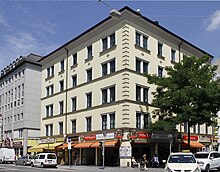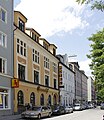Schillerstrasse (Munich)
| Schiller Street | |
|---|---|
| Street in Munich | |
| Schillerstrasse, Bahnhofsviertel | |
| Basic data | |
| State capital | Munich |
| Borough | Ludwigsvorstadt-Isarvorstadt |
| Hist. Names | Singstrasse |
| Name received | 1860 |
| Connecting roads | Bahnhofplatz |
| Cross streets | Bayerstrasse , Adolf-Kolping-Strasse, Schwanthalerstrasse , Landwehrstrasse , Pettenkoferstrasse, Nussbaumstrasse |
| Numbering system | Orientation numbering |
| use | |
| User groups | Pedestrian traffic , bicycle traffic , individual traffic |
| Technical specifications | |
| Street length | 700 m |
The Schiller Street in Munich is a 700 m long road in north-south direction in the district Ludwigsvorstadt downtown. It starts at the intersection with Bayerstraße at Bahnhofplatz near Munich Central Station and runs in a straight line to Nussbaumstraße in the clinic district. Schillerstraße is the first parallel street to the Altstadtring outside of the medieval old town. It is named after Friedrich Schiller and runs parallel to the neighboring Goethestrasse to the west .
character
The street begins with an entrance to the Hauptbahnhof underground station and a taxi rank. Its northern part is to be assigned to the station district with all relevant effects, with a mixture of hotels , amusement arcades , ethnic grocery stores, social facilities and snack bars as well as the red light scene with erotic shops and night clubs .
The hotel density in Schillerstraße is higher than in any other Münchner Straße, so that in 2019 the city administration announced a hotel concept for the southern Bahnhofsviertel as a result of a further construction project. There, 60% of all hotel beds in the city are concentrated on 0.2% of the city's area. The city is aiming for a mixed use of commercial and around 30% residential use, but the existing development plans allow 100% commercial and especially hotels.
This section is strongly influenced by migrants of various origins. In the backyards of Schillerstrasse, a double-digit number of small and tiny prayer rooms and mosques were used at times. However, since 2017 there has been no mosque in the district; they all had to close because the crowd overwhelmed the small rooms and fire protection regulations could not be observed.
The middle section around the intersections with Schwanthalerstrasse and Landwehrstrasse belonged to the so-called Schillicon Valley , which since the 1990s has been jokingly named after Schillerstrasse because of the many computer and electronics stores based on Californian Silicon Valley . Since 2005, the density of electronics stores has been falling sharply. A courtyard that connects Schillerstrasse with Goethestrasse, and all of the associated buildings, is the seat of the Guild for Electrical and Information Technology in Munich. Due to the narrow development and to calm the traffic, the northern and central parts up to Landwehrstraße are designated as one-way streets in north-south direction.
The south is assigned to the clinic district of the inner city clinic of the University of Munich . The physiological and other institutes, a student union cafeteria and company apartments for the staff of the clinics are located on Schillerstraße . An ambulance is stationed at the Institute for Emergency Medicine and Medical Management . Even if the main entrances are on Pettenkoferstraße and Nussbaumstraße, Schillerstraße is also characterized by the side wing of the anatomical institute , a neoclassical wing with a domed central complex, built in 1905-08 by Max Littmann , and the surgical clinic. Schillerstrasse ends bluntly at Nussbaumstrasse; Opposite it, the new portal clinic of the inner city clinic will be built by 2020. The southernmost hundred meters of the street are closed to general motorized traffic and belong to the restricted-access part of the clinic premises.
As part of the redesign of the clinic quarter after the move of most of the facilities to the Großhadern campus in 2012, the surgical clinic will be closed and its function, like that of most other inner city clinics, will be combined in a new portal clinic, which will be built on the property at the end of Schillerstraße .
history
The middle section of today's Schillerstraße between today's Pettenkoferstraße and Schwanthalerstraße was already marked as Sing-Straße in the urban plans at the beginning of the 19th century , but was initially only used for gardens due to its location on the edge of the built-up area. Like the whole district, it was originally designed for loose development with villas on spacious lots. The character did not change until the second half of the 19th century.
In 1825 Leo von Klenze built the Alte Anatomie at the southern end, near the general hospital . Until around 1830, the development expanded from what was then Reberstrasse, then briefly Lerchenstrasse, today's Schwanthalerstrasse to Sing Strasse and southwards.
The section of Ludwigsvorstadt called Schwanthalerquartier was redesigned in the middle of the 19th century in connection with the construction of the Centralbahnhof in 1849 as an urban residential and commercial district. The Sing-Straße was broken through to the north to the station square and built on according to plan. In 1860 it was renamed Schillerstraße and in the following years it was extended south to today's Nussbaumstraße. In 1865 the parallel Heustraße was renamed Goethestraße when Ludwigvorstadt was expanded to the west. In the following years, the neighboring Wiesenviertel to the west was designed as a high-quality, green residential area on the eastern part of the Theresienwiese , and Goethestrasse was upgraded to become a north-south axis. As part of the development of the Wiesenviertel from the 1880s, it was later moved in the southern section west of the hospital to Lindwurmstrasse and the new Goetheplatz.
The house of the Adam family of painters in what was then Sing-Strasse has been documented since 1829 . By the First World War , Schillerstrasse had developed into an artists' quarter; around 1890 there were at least 18 studios on four neighboring properties, seven of which were in the rear building at number 26. On February 8, 1880, the painter Franz Marc was born in Schillerstrasse 35.
In the Schillerstraße, due to severe destruction in the Second World War, little of the original late Biedermeier and neoclassical buildings has been preserved. Klenze's Alte Anatomie had to be demolished due to war damage, and the building line on the east side was set back in order to widen the road for traffic. Two residential buildings from this period are listed as historical monuments . At the corner of Schillerstraße and Pettenkoferstraße there is a Baroque-style building that was built in 1899 as a station for a substation with a transformer for Munich's early electrical power supply and today houses a university institute. Other preserved buildings date from the early 20th century and the Art Nouveau and Neo-Renaissance . The majority of today's buildings were built in the simplest and cheapest way of building during the reconstruction after the Second World War.
At the beginning of the 20th century, Julius Friedrich Lehmann founded his original medical specialist publisher at Schillerstraße 51 in the Klinikviertel, which soon also published folkish and racial writings and was one of the pioneers of National Socialism in Munich . In the post-war period, a number of music clubs developed in and around Schillerstraße, aimed specifically at the white GIs of the American occupation forces. They played rock 'n' roll and boogie woogie . The clubs were influential in developing a musical culture among the young German population.
On April 4, 1977, Bayerischer Rundfunk showed a 45-minute long film by Georg Friedel about Schillerstrasse in the series Unter Unser Himmel , which was shown again on December 15, 2009. It mainly describes the life of guest workers , who in the late 1970s were still viewed as migrant workers and not as immigrants .
On January 7, 1984 , the two terrorists of the Ludwig group carried out an arson attack on the Liverpool Red Light Club on Schillerstrasse . A young woman died three months later from her injuries.
Web links
- City of Munich: Ludwigvorstadt-Isarvorstadt cultural history trail: Schillerstraße (pages 24/25) (PDF; 3.1 MB)
Individual evidence
- ^ A b Hans Dollinger : The Munich street names . Südwest Verlag, Munich 2007, ISBN 978-3-517-08370-4 , page 275
- ↑ John Brickerhoff Jackson: The Stranger's Path (1957). In: Brigitte Franzen, Stephanie Krebs: standschaftstheorie . Verlag Walter König 2005, ISBN 3-88375-909-0 , pp. 16-28
- ^ Diakonie: Bodelschwingh House
- ↑ Abendzeitung: Hotel density in the city center - the city is developing a hotel concept , July 19, 2019
- ↑ a b Cultural Department of the City of Munich : Cultural History Trail Ludwigvorstadt-Isarvorstadt: Schillerstraße (pages 24/25) (PDF; 3.1 MB)
- ↑ sueddeutsche.de: Muslims have hardly any place to pray in Munich , April 2, 2017
- ↑ Term is used by specialist media ( crn.de, 2015 )
- ↑ report in the trade magazine Channel Partner, 1997
- ↑ crn.de: A visit to the Munich computer mile »Schillerstraße« - »IT products are thrown at customers« , March 5, 2010
- ↑ List of monuments: D-1-62-000-5272, main entrance and house address from Pettenkoferstraße
- ↑ List of monuments: D-1-62-000-4814, Surgical Clinic, the old building neo-renaissance, 1889-91 by Arnold Zenetti , the entrance building neo-baroque, 1894 by Theodor Fischer , the west wing 1914-15 and 1920-21 by Theodor Kollmann .
- ↑ Münchner Merkur: This is what the new university clinic looks like , September 13, 2013
- ↑ Süddeutsche Zeitung: ( Page no longer available , search in web archives: City council approves clinic concept, February 16, 2012 )
- ↑ Bavarian Regional Library Online: local journal of the city of Munich from 1816
- ↑ Denis A. Chevalley: The urban development in the southern and western urban areas on the left of the Isar . In: Denis A. Chevalley, Timm Weski: Monuments in Bavaria - State Capital Munich, Southwest, Volume I.2 / 2 . Lipp, Munich 2004, ISBN 3-87490-584-5 , page XXVII
- ↑ Bavarian Regional Library Online: local journal of the city of Munich from 1830
- ↑ Bavarian Regional Library Online: local journal of the city of Munich from 1853
- ^ Hans Dollinger: The Munich street names . Südwest Verlag, Munich 2007, ISBN 978-3-517-08370-4 , page 106
- ↑ Denis A. Chevalley, Timm Weski: Monuments in Bavaria - State Capital Munich, Southwest, Volume I.2 / 2 . Lipp, Munich 2004, ISBN 3-87490-584-5 , pages 240-244
- ↑ a b Denis A. Chevalley, Timm Weski: Monuments in Bavaria - State Capital Munich, Southwest, Volume II.2 / 2 . Lipp, Munich 2004, ISBN 3-87490-584-5 , pages 564-566
- ↑ List of monuments: D-1-62-000-3793, Landwehrstraße 31 / corner of Schillerstraße, corner house, late Biedermeier style, 1860 by Joseph Hönig ; Memorial plaque from 1894 for the optician Adolf Steinheil and D-1-62-000-6359, Schwanthalerstraße 24 / corner Schillerstraße, corner house, in classical tradition, probably around 1870/80.
- ↑ List of monuments: D-1-62-000-6169 ( Memento of the original from October 21, 2014 in the Internet Archive ) Info: The archive link was inserted automatically and has not yet been checked. Please check the original and archive link according to the instructions and then remove this notice. , Schillerstraße 53, Former electrical substation, baroque style, 1899 by Carl Hocheder (adjoining building of the surgical clinic (Nussbaumstraße 20)), honorable mention at the facade price 2005
- ↑ List of monuments: D-1-62-000-6167, Schillerstrasse 20, tenement house, Art Nouveau corner building, 1905 by August Zeh and D-1-62-000-6168, Schillerstrasse 36, tenement house, reduced German Renaissance, 1910 by Eugen Behles .
- ↑ Florian Fricke: Munich Rocks. Strube 2007, ISBN 978-3899121087 , p. 7
- ↑ Bayerischer Rundfunk: ( page no longer available , search in web archives: Schillerstraße 3–53, age and faces of a street (accessed on July 9, 2010) )
- ↑ Die Zeit: The Merciless , December 5, 1986
Coordinates: 48 ° 8 ′ 20.4 ″ N , 11 ° 33 ′ 40.3 ″ E









